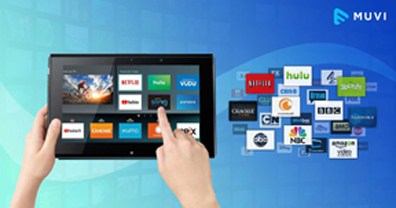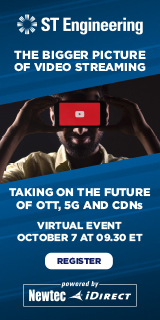Satellite in an OTT World
by Elisabeth Tweedie
Los Angeles, Calif., September 8, 2020--"Over-the-top (OTT) streaming services overtake cable and satellite viewing in USA.” “More Netflix viewers than Sky satellite TV viewers in the UK.” As you read headlines like these, it would be easy to think that satellite, not only as a Direct-to-home (DTH) service, but also as a content delivery provider has lost its place in the value chain. Nothing could be further from the truth. There are many reasons why satellite will continue to be both necessary, relevant and indeed an essential partner for key players in the OTT industry, and this MarketBrief will examine the key ones.
 But first a quick look at the numbers behind those headlines. From an adjunct to its DVD rental service in the US in 2007, Netflix, globally the most popular OTT video service, now boasts 182 million subscribers in 190 countries. Amazon Prime, the second most popular service, doesn’t release streaming numbers, but is generally regarded to have around 100 million users in the US alone.
But first a quick look at the numbers behind those headlines. From an adjunct to its DVD rental service in the US in 2007, Netflix, globally the most popular OTT video service, now boasts 182 million subscribers in 190 countries. Amazon Prime, the second most popular service, doesn’t release streaming numbers, but is generally regarded to have around 100 million users in the US alone.
Unsurprisingly, traditional broadcasters have not taken this lying down, and many around the world have launched their own OTT streaming services. The most well-known and successful being Disney+, which at the beginning of August 2020, less than nine months after its launch, had 60.5 million subscribers. Whilst these, and a few others: Hulu, YouTube, Britbox, HBO Max for example, are household names, there are many more OTT services. According to SNL Kagan, globally there were close to 1,000 streaming services at the end of 2018, some national, some international. Between them, according to Strategy Analytics these services had 809 million Subscription Video-on-Demand (SVOD) subscribers in 2019 and this is expected to grow to 1.43 billion by 2025. SVOD is the largest OTT segment, but there are also advertising supported services (AVOD), and now also download to own (DTO) and Pay per View (PPV). The latter is becoming particularly relevant for both live events, particularly sports and concerts, and recently, due to the fact that most theaters are closed, also for new movie releases.
Actual subscriber numbers only tell part of the story. In many regions of the world, subscribers use the service on multiple devices: television, laptop, tablet and phone. In the US the average household has three devices on which video is viewed, and in many households all three, or more, will be being used simultaneously, sometimes by one user but more often by different members of the household. By definition, OTT is a unicast service. So three devices equates to three separate video streams. Streams which all need to be delivered in different formats, bit rates and coding depending on the device.
Subscriber numbers are important, so too is the amount of time that those subscribers are spending watching online (OTT) video. According to the State of Online Video 2019 from Limelight Networks, globally online video viewing increased by 59% from 2016 to an average of 6.8 hours per week. This compares to a global average of 7.2 hours per week viewing broadcast, cable or satellite video. These average figures, hide some interesting variations. At 7.62 hours, Singaporeans for example, spend nearly two more hours a week watching online than they do watching linear video (5.73 hours), whereas the Italians watch just over an hour and half more linear video (8.99 hours) than online video (7.35 hours). As would be expected, younger viewers (under 35 years of age) are watching more online video and are also less likely to watch any linear video, with 23% saying that they do not watch any, compared to only 14% of those over 60 years of age who state the same.
Covid-19 Impact
Those numbers of course, are pre-Covid-19. In March of this year, large parts of the world went into lockdown mode. For many, this meant working from home and using online courses and video platforms for education. For others, their jobs were such that they couldn’t be done from home, so suddenly they were in a stressful situation with a lot of spare time on their hands. It is hardly surprising that many used this time to watch more video, primarily OTT video. Live sporting events, one of the key drivers of linear viewing, were canceled, further pushing viewers to OTT services. In the UK for example, a report from Enders Analysis, indicated that between March 16th and April 19th linear and catch-up TV saw an increase in viewing time of 23%, while “unmatched” TV usage increased by 75%. Unmatched TV usage, is time spent using the TV for things other than linear and catch-up TV viewing: primarily OTT and gaming. The increase in linear viewing is largely attributed to an increased thirst for news, and already viewing has fallen back to 2019 levels as news exhaustion and overload set in.
Unsurprisingly, this dramatic increase in numbers, put a lot of pressure on the broadband network. In many countries OTT providers, either voluntarily or at the request of government or network providers, downgraded the quality of the video stream to reduce bandwidth pressure, but this wasn’t always enough. Simultaneously delivering so many individual streams, presents a challenge, not just to the last mile, but to the backbone itself, as Netflix found out when many subscribers lost access at the end of March. The outage only lasted for about an hour, but it impacted viewers in Northern Europe as well as across large parts of the US. Network overload is a real issue, particularly for live events which cause a dramatic surge in viewers; and a problem that is only likely to get worse as subscriber numbers increase, concurrent with the continuing migration to 4K, with the associated demands on bandwidth.
Other Sectors
Streamed video is not confined solely to the entertainment sector. There are many smaller, but significant niche markets, of which education, particularly in the wake of Covid-19 is the most well-known. Around the world, schools and universities have turned to online teaching as classrooms have been shut down. Educators have used a combination of methods: some online classes, using a videoconference app such as Zoom, or Panopto, (a platform specifically designed for universities and large organizations), for streaming of pre-recorded classes for students to do in their own time and online study groups. In many areas, broadband infrastructure is both available and adequate to meet this need; in others it is not, and that is when organizations turned to satellite. For example, in Alaska, OpimERA, an ISP in the town of Unalaska, immediately increased its leased capacity from SES in order to be able to provide distance learning and telemedicine services in the town. Similarly, in the UAE, the Abu Dhabi Department of Education and Knowledge (ADEK) collaborated with Yahsat to provide free satellite broadband services for distance learning students residing in the Al Dhafra region. With ADEK’s support, Yahsat, the leading satellite operator in the UAE, will offer its services free of charge to support students’ distance learning needs until the end of the current academic year.
For households that don’t have a computer, but do have a television, ST Engineering iDirect have developed a solution that allows content to be pushed to a specially adapted set-top box (STB) for viewing on tablets or mobile phones, as well as on a traditional television. If required and available, the internet could be used as a return path.
However, in some parts of the world, a shortage of teachers, poor infrastructure or simply being remote necessitate distance learning via satellite. According to UNICEF over 121 million primary and secondary school age children, cannot attend school. A number of factors may contribute to this situation, but satellite can address one of the key ones: location. Children living in the outback of Australia, for example. Although distance learning has been available there for many years, going back to the Radio School of the Air; the launch of the NBN broadband satellites has made a huge difference in the quality of the lessons. Immediately prior to the NBN launch distance learning was available via the Interim Satellite Service, but bandwidth was severely limited. One family with three children to educate and a farm to run, was limited to 20GB a month. The family now has an allowance of 50GB per child, plus an additional general allowance for everything else.
Another example is Project iMlango deployed across Kenya to educate 180,000 marginalized children. This project is led by Avanti  Communications and the UK Department for International Development (DFID). The broadband solution utilizes Hylas-2 to deliver the e-learning program to 245 rural and remote schools in Kenya. Preliminary results students who have access to the individualized learning platform for 60 minutes per week improve their “maths age” by on average, 18 months within their first year of access.
Communications and the UK Department for International Development (DFID). The broadband solution utilizes Hylas-2 to deliver the e-learning program to 245 rural and remote schools in Kenya. Preliminary results students who have access to the individualized learning platform for 60 minutes per week improve their “maths age” by on average, 18 months within their first year of access.
Mobile is of course another niche segment for satellite video. As well as the current maritime and aeronautical applications, with the development of a suitable antenna, the connected car market will open up. Streaming video for passengers and software updates are two potential applications.
Enterprise video is another growing market segment. In the fashion industry for example, a large retailer may have a video for every item of clothing on its website.
The Ecosystem
Prior to emergence of OTT services, content delivery was a relatively straight forward process of distributing programs to the headend. Satellite provided the means to do this reliably and cost-effectively and MVPDs (Multichannel Video Programming Distributors) usually leased transponders or bought satellite time, directly from the satellite operator or from an independent provider to do this.
OTT, coupled with the multiple viewing devices that are now in use around the world, turned this simple operation on its head, changing it into a far more complex procedure. Instead of one format, every piece of content has to be formatted and encoded for thousands of different devices. Instead of one copy of a program residing at the headend to be shown at the same time for everyone, multiple copies in multiple formats are needed so as to satisfy the on-demand nature inherent to an OTT service. For an advertising supported OTT (AVOD) service, a SCTE metadata marker needs to be inserted to indicate the correct placement of advertisements. Depending on the service these could be national, local or even personal and a separate feed needs to be generated for each. For all the OTT services, vast amounts of usage data are collected so as to be able to personalize recommendations. In other words, the nature of the video business has changed drastically.
Satellite’s Advantages
Historically, video has been the bread and butter of commercial satellite revenues and whilst broadband and mobile are increasing their importance, video remains a key market, still accounting for well over 50% of revenue. Nevertheless, the growth in OTT, particularly given the numbers of younger viewers who do not watch any linear TV, is posing a threat to the long-term viability of this segment. In order to protect this revenue, satellite operators, service providers and technology vendors alike need to adapt to the new reality of a hybrid world, that still needs traditional linear video, but also needs OTT. Flexibility is the key.
Fortunately, satellite operators and vendors are not standing idly by and many, if not most, are looking for ways to participate in this burgeoning industry. Various approaches targeted at different parts of the ecosystem are being taken in order to keep satellites relevant and capitalize on its high bandwidth, multicast efficiencies. As a unicast service, the more successful OTT becomes, the more pressure there is on the broadband delivery pipe. As already stated, this situation will only get worse as numbers of users and devices increase, at the same time as constantly improving video quality demands increased bandwidth.
This can be a win-win situation. OTT really needs the multicast capabilities of satellite to distribute the vast amount of content that it generates. The satellite industry on the other hand, needs to evolve in order to protect a key business segment.
For the OTT service provider, satellite has a lot to offer:
- It can take pressure off the backbone by delivering prime content in multiple formats, to the edge of the network, whether that be a headend, cell tower, or STB.
- The return channel can be used for much needed analytical data.
- Coding can ensure that digital rights (DRM) are adhered to, and content is only delivered to the region for which its licensed, and only in the correct viewing window.
- It can elevate the quality of experience (QoE) for the viewer, by delivering to the edge, so reducing if not eliminating the likelihood of buffering occurring.
- Similarly, latency between a broadcast signal and the OTT signal is eliminated, greatly elevating the QoE for a sports viewer.
- It can extend the geographical reach of an OTT service into areas without a good terrestrial broadband link.
- It can grow with the service, scaling up rapidly and cost-effectively as numbers of users and devices increase.
- Satellite operators and service providers, have many years’ experience of packaging and delivering video programing, something that many new OTT providers lack.
The Way Forwards – A Win-Win Situation
Teleport operators and service providers have been at the front end of this revolution and have had to respond accordingly. Many have totally changed their business model, and evolved from selling bandwidth to selling a managed network service, as clients didn’t want to take on the complexities of an OTT network. This necessitated retraining RF engineers to become IT professionals and/or recruiting additional staff with the necessary skills. Some have entered into partnerships with telcos and data centers.
OTT services are distributing an increasing number of live events. Sometimes in tandem with a broadcast network, and sometimes independently. This is an area that teleport operators have vast experience with. From capturing and uplinking the event, to packaging and distributing it, with end-user authorization and authentication on a PPV basis. This is a key service that can be offered to OTT providers.
Several of the technology providers are also at the forefront of this revolution, developing new products and software that will help pivot the satellite industry into the heart of the OTT business.
One approach from Broadpeak, known as nanoCDN™, uses adaptive bit rate (ABR) streaming formats (such as HLS and DASH formats for delivering video over the web) over satellite, to transform the unicast OTT video stream to multicast at the headend for delivery over the network. At the home it is transformed back into a unicast stream for viewing on WiFi connected devices, at the same quality as a DTH broadcast. This means that OTT and satellite can be merged to offer a consistent experience, whilst at the same time offering additional services on the STB, such as content personalization and targeted advertising, that otherwise are only available on mobile devices. nanoCDN™ employs various optimizations such as HTTP chunked transfer encoding and CMAF chunking to reduce latency after encoding to a negligible amount. From the OTT service provider’s point of view, utilizing nanoCDN™ significantly improves the user quality of experience (QoE), minimizes bandwidth and significantly reduces latency. In 2019 nanoCDN™ was the recipient of the Teleport Technology of the Year award and NAB Product of the Year award.
Eutelsat has been utilizing nanoCDN™ in its Cirrus service for several years, and last year invested 10 million Euros in the company. Cirrus is a service designed to deliver content both OTT (from a cloud) and via a DTH service, permitting the user to view content anytime, anywhere and on any device. As well as delivering the content, Cirrus provides user analytics and digital rights management (DRM). Eutelsat is working with several other industry partners including AWS, Irdeto, Dolby, Nagra Kudelski and Babeleye as well as Broadpeak. Customers include Orao Telecom (Congo) who are using Cirrus to provide an OTT service to the Congalese diaspora, and Mondo Globo/MCNC who are using the service to provide Arab language programming to hotel guests in Europe. Edwardian Hotels in London are one of hotel groups utilizing this service.
An alternative, but similar approach, is that adopted by Anevia and Quadrille who have partnered to deliver OTT over satellite. The solution enables content providers and operators to offer live-TV services in situations where it was previously unavailable due to limited bandwidth. The OTT Stream is delivered via satellite, and at the receiving end, the signal is re-transformed to enable Multi-screen viewing on any smart device. Initial applications are targeted at high-speed trains, in-flight entertainment and universities.
SES has taken a somewhat different approach and last year introduced a new product simply branded as “Satellite and OTT in Sync.” It works by removing the source signal traveling to the satellite and distributes it via IP in tandem with satellite. By applying low-latency encoding and tuning to the IP stream at the source, the system can deliver content to OTT platforms in sync with the satellite signal. This removes seconds of delay between a traditional linear broadcast and regular OTT delivery of live programming. Obviously, the key target market for this is live sports so as to eliminate the annoying delay between a linear and OTT signal at that crucial moment. Apart from their own team losing, there are few things more frustrating to a sports viewer than watching a match on a streamed service and hearing the roar from the pub down the road, as satellite viewers witness a crucial goal seconds before they do! SES won the bronze prize for this product, in the category “Advancing the TV User Experience” at the Videonet 2020 Connected TV awards.
SES also offers an alternative approach to OTT delivery, for areas lacking high speed internet connectivity, known as VoD Everywhere. This service pushes a regularly updated content selection based on a users’ profile, to a STB. It’s then made available to all WiFi connected devices in the home, with all the normal play and pause features.
As already mentioned, AVOD local or even personal advertisements need to be inserted into the video stream. In order to offer this service SES has partnered with Nowtilus, a provider of targeted dynamic in-stream ad-insertion solutions.
ST Engineering iDirect Solutions
ST Engineering iDirect, named earlier this year as “One of the top ten hottest satellite companies” is another company that is very actively looking to the OTT future, developing products and applications to propel its satellite customers into the OTT business.
On the contribution side, Newtec Dialog® from ST Engineering iDirect is ideally suited for news gathering. These days, it is rare that a full crew will be sent to a breaking news site, so the whole process needs to be automated. Dialog® sets up a bi-directional IP pipe to the studio quickly and efficiently, without the need for technical assistance.
On the distribution side, the company teamed with DVB at IBC last year, to demonstrate DVB-I, an ongoing initiative to develop technical standards for delivering television services over IP. DVB-I can be a standalone delivery or could combine broadcast and IP to create a single hybrid offering. “Historically, satellite has been overlooked as an enabler of OTT services, but its synonymity with broadcast and its capability to deliver high-quality, reliable transmissions anywhere, makes it ideal to enable universal OTT television services,” said Thomas Van den Driessche, then CEO of Newtec, now President and CCO ST Engineering iDirect, “We have a long history of being involved in developing DVB standards and we are pleased to be able to support this latest initiative which will significantly increase service availability, especially for users who don’t have access to broadcast television.” The demonstration utilized the MCX7000 modem to provide the content for the DVB-T2 and OTT transmissions. The hybrid reception at the customer’s site is a combination of DVB-T2 (or S2) and OTT.
Delivery of OTT content in a timely manner, is important as already explained. Equally important is being able to provide analytics and digital rights management. OTT services tend to be highly personalized and the first screen that a viewer sees and the recommendations given are related to their individual profile. So, knowing precisely how a subscriber is using the service is very important: this information will be used for targeted advertising, monitoring, and providing a suitable QoE. Digital Rights Management is important to ensure that content is only shown in locations for which the operator is holding a license and in the appropriate release window. Dialog® hubs provide the necessary return path for these CDN analytics and the operation of DRM in the Cloud. The forward pipe will efficiently transport live content to feed the edge CDN servers, whilst the return channel can be used for feedback analytics and DRM, if there are no alternative terrestrial return channels.
 |
| To read or download a pdf of the full report on Satellite in an OTT sponsored by ST Engineering iDirect click here. |
Dialog® was also used in the ARK Mediacom, Inc. demonstration of the first end-to-end delivery of IP streaming video content. Intelsat provided the satellite IP transmission via their gateway and uplink services employing Dialog to establish a bi-directional IP pipe with the reception site. These ARK 5G and ATSC 3.0 trials demonstrated the ability to simulcast content across a nationwide IP multicast network, enabling virtually unlimited OTT video and IP delivery straight to customers.
Working with Broadpeak, ST Engineering iDirect utilized its M6100 Modulator to help power Astro Malaysia Holdings OTT service. The pay-TV operator offers public venue and business owners the facility to offer an Astro OTT service that takes its signal from satellite and then distributes live and on-demand programming over Wi-Fi to on-site customers. Venue users can therefore watch TV on their mobile devices via an app, or on Android TV-based television sets in the building. Broadpeak’s nanoCDN™ technology is being used to deliver 20 live MPEG-DASH channels.
As can be seen from the examples above, partnerships are the name of the game. ST Engineering iDirect, is working with a variety of service and technology providers to facilitate and enhance OTT delivery services. These include ARK, Mediacom/Intelsat on the service side and Broadpeak, Quadrille and EKT for technology, as well as Tier-1 broadcasters. As Hans Massart, Head of Media & Broadcast, ST Engineering iDirect said: “We are constantly innovating and developing strong technological partnerships that enable us to spearhead satellite’s place in the OTT ecosystem. We are continuing to forge the path to the future of OTT, enabling providers to deliver content anywhere and for a multitude of use cases.”
Conclusion
OTT is an evolving and complex business. The satellite industry has a lot to offer to facilitate its continuing success. The ability and capacity to take content to the edge is obviously paramount; but more than that, combined, the players can provider years of experience capturing, processing, packaging and delivering content. Something the OTT players badly need. A win-win situation.
-----------------------------
 Elisabeth Tweedie has over 20 years experience at the cutting edge of new commmunications entertainment technologies. She is the founder and President of Definitive Direction (www.definitivedirection.com), a consultancy that focuses on researching and evaluating the long-term potential for new ventures, initiating their development, and identifying and developing appropriate alliances. During her 10 years at Hughes Electronics, she worked on every acquisition and new business that the company considered during her time there. She can be reached at etweedie@definitivedirection.com
Elisabeth Tweedie has over 20 years experience at the cutting edge of new commmunications entertainment technologies. She is the founder and President of Definitive Direction (www.definitivedirection.com), a consultancy that focuses on researching and evaluating the long-term potential for new ventures, initiating their development, and identifying and developing appropriate alliances. During her 10 years at Hughes Electronics, she worked on every acquisition and new business that the company considered during her time there. She can be reached at etweedie@definitivedirection.com






